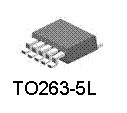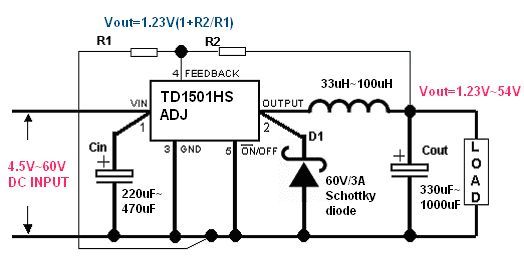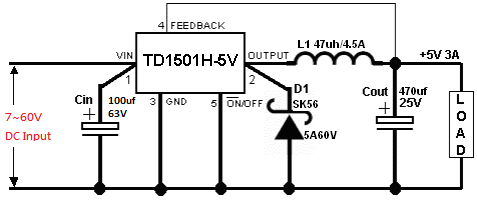
The TD1501H is a series of easy to use fixed and adjustable step-down (buck) switch-mode voltage regulators. These devices are available in fixed output voltage of 3.3V, 5V, and an adjustable output version. Both versions are capable of driving a 3A load with excellent line and load regulation.
Requiring a minimum number of external components, these regulators are simple to use and include internal frequency compensation, and a fixed-frequency oscillator.
The output voltage is guaranteed to ±3%
tolerance under specified input voltage and
output load conditions. The oscillator frequency is
guaranteed to ±15%. External shutdown is
included, featuring typically 80 μA standby current.
Self protection features include a two stage
frequency reducing current limit for the output
switch and an over temperature shutdown for
complete protection under fault conditions.
The TD1501H is available in TO-220B-5L
TO220-5L and TO-263-5L packages.
•3.3V,5V and Adjustable output versions
•Output adjustable from 1.23V to 57V
•Fixed 150KHz frequency internal oscillator
•Guaranteed 3A output load current
•Input voltage range up to 60V
•Low power standby mode, IQ typically 80 µA
•TTL shutdwon capability
•Excellent line and load regulation
•Requires only 4 external components
•High efficiency
•Thermal shutdown and current limit protection
•Available in TO-220B TO220 and TO-263
• PoE Switch/PoE hub/PoE IP cameras
• Simple High-efficiency step-down regulator
• Telecom/Networking
• On-card switching regulators
• Positive to negative converter
• LCD monitor and LCD TV
• DVD recorder and PDP TV
• Battery charger
• Step-down to for microprocessors
 |
||
| TO220B-5L | TO220-5L | TO263-5L |
| TO220B-5L/TO220-5L |
| TO263-5L |
| Name | Description |
|---|---|
| Vin | Input supply voltage |
| Output | Switching output |
| Gnd | Ground |
| Feedback | Output voltage feedback input |
| ON/OFF | ON/OFF shutdown Active is“Low”or GND |
Circuit ground.


Figure 3. Typical Application of TD1501HADJ
| Parameter | Value | Unit |
|---|---|---|
| Supply Voltage Vin | -0.3 to 62 | V |
| Feedback Pin Voltage | -0.3 to +0.3 | V |
| ON/OFF Pin voltage | -0.3 to +25 | V |
| Output pin voltage | -0.3 to +0.3 | V |
| Output Voltage to Ground (Steady State) | -1 | V |
| Power Dissipation | Internally limited | mW |
| Operating Junction Temperature Range | -40 to +125 | °C |
| Storage Temperature | -65 to 150 | °C |
| Lead Temperature (Soldering, 10 sec) | 200 | °C |
| ESD(HM) | 4000 | V |
| Symbol | Parameter | Conditions | Min. | Typ. | Max. | Unit |
| Ib | Feedback bias current | Adjustable only, VFB=1.3V | 10 | 50/100 | nA | |
| IQ | Quiescent current | VFB=12V force driver off | 5 | 10 | mA | |
| ISTBY | Standby quiescent current | ON/OFF=5V, VIN=36V | 80 | 200/250 | uA | |
| FOSC | Oscillator frequency | 127 | 150 | 173 | KHz | |
| VSAT | Saturation voltage | IOUT=3A | 1.4 | 1.8/2.0 | V | |
| ICL | Current Limit | Peak Current (VFB=0V) | 4.5 | 5.5/6.5 | A | |
| IL | Output leakage current | Output=0V (VFB=12V) | 50 | uA | ||
| Output leakage current | Output=-1V (VIN=36V) | 2 | 30 | mA | ||
| VIL VIH |
ON/OFF pin logic input | Low (Regulator ON) | 1.3 | 0.6 | V | |
| Threshold voltage | High (Regulator OFF) | 2.0 | 1.3 | V | ||
| IH<br /> IL | ON/OFF pin input current | VLOGIC=2.5V(Regulator OFF) | 5 | 15 | uA | |
| VLOGIC=0.5V(Regulator ON) | 0.02 | 5 | uA | |||
| θJC | Thermal Resistance | TO220B-5L/TO220-5L | 2.5 3.5 |
OC/W | ||
| Junction to Case | TO263-5L | |||||
| θJA | Thermal Resistance | TO220B-5L/TO220-5L | 28 23 |
OC/W | ||
| Junction to Ambient | TO263-5L | |||||
| (Note1) | ||||||
| TD1501H ADJ |
Vout: Output Voltage | 11V≦VIN≦60V, 0.2A≦ILOAD≦3A, VOUT for 9V | 1.193/ 1.180 |
1.23 | 1.267/ 1.28 |
V |
| η: Efficiency | VIN=12V,ILOAD=9V,ILOAD=3A | 88 | % | |||
| TD1501H 3.3V |
Vout: Output Voltage | 4.75V≦VIN≦60V, 0.2A≦ILOAD≦3A | 3.168/ 3.135 |
3.3 | 3.432/ 3.465 |
V |
| η: Efficiency | VIN=12V, ILOAD=3A | 76 | % | |||
| TD1501H 5V |
Vout: Output Voltage | 7V≦VIN≦60V, 0.2A≦ILOAD≦3A | 4.800/ 4.750 |
5 | 5.200/ 5.25 |
V |
| η: Efficiency | VIN=12V,ILOAD=3A | 83 | % |
Note1: Thermal resistance with copper area of approximately 3 in2.
****************************************************************************************************************
 |
 |
| Figure 4. Output Voltage vs. Temperature | Figure 5. Switching Frequency vs. Temperature |
 |
|
| Figure 6. Output Saturation Characteristics | Figure 7. Quiescent Current vs Temperature |
 |
 |
| Figure 8. ON/OFF Pin Voltage | Figure 9. ON/OFF Pin Voltage |
 |
|
| Figure 10. Output Saturation Characteristics |
Typical Application Circuit (TD1501H50 5V Fixed Output Voltage Version)

Typical Application Circuit (TD1501HSADJ Adjustable
Output Voltage Version)

TD1501HSADJ Vout VS. R1, R2, Cf Select Table
| Vout | R1 | R2 | Cf(Optinal) |
3.3V |
1.6K | 2.7K | 33nf |
| 5V | 3.6K | 11K | 10nf |
| 9V | 6.8K | 43K | 1.5nf |
| 12V | 1.5K | 13K | 1nf |
| Vin (Max) |
2A Load Current | 3A Load Current | ||||
|---|---|---|---|---|---|---|
| Part Number | Package | Vendor | Part Number | Package | Vendor | |
| 20V | B220/A | SMB/SMA | 1 | B320/B/A | SMC/B/A | 1 |
| SS22 | SMA | 2,3 | SS32 | SMC | 2,3 | |
| MBRS320 | SMC | 4 | ||||
| SK32 | SMC | 6 | ||||
| IN5820 | D0-201AD | 6 | ||||
| 30V | B230/A | SMB | 1 | B330/B/A | SMC/B/A | 1 |
| SS23 | SMB | 2,3 | SS33 | SMC | 2,3 | |
| 20BQ030 | SMB | 4 | MBRS330 | SMC | 4,5 | |
| MBRS230 | SMB | 5 | SK33 | SMC | 3,6 | |
| SK23 | SMB | 6 | IN5821 | D0-201AD | 2,6 | |
| 40V | B240/A | SMB/SMA | 1 | B340/B/A | SMC/B/A | 1 |
| SS24 | SMB | 1,3,5 | SS34 | SMC | 2,3 | |
| MBRS240 | SMB | 5 | Q0BQ040 | SMC | 4 | |
| MBRS340TR | SMC | 4,5 | ||||
| SK34 | SMC | 6 | ||||
| IN5822 | D0-201AD | 6 | ||||
| 50V | B250 A | SMB/SMA | 1 | B350/B/A | SMC/B/A | 1 |
| SS25 | SMB | 2,3 | SS35 | SMC | 2,3 | |
| SK23 | SMB | 5 | MBRS330 | SMC | 4,5 | |
| SK35 | SMC | 3.6 | ||||
| Vin (Max) |
4A Load Current | 5A Load Current | ||||
|---|---|---|---|---|---|---|
| Part Number | Package | Vendor | Part Number | Package | Vendor | |
| 20v | SL42 | SMC | 2,3 | B520C | SMC | 1 |
| SR502 | DO-201AD | 1 | ||||
| SB520 | DO-201AD | 2 | ||||
| IN5823 | DO-201AD | 6 | ||||
| 30V | SL43 | SMC | 2,3 | B530C | SMC | 1 |
| SR503 | DO-201AD | 1 | ||||
| SB530 | DO-201AD | 2 | ||||
| SSC53L | SMC | 3 | ||||
| IN5824 | D0-201AD | 6 | ||||
| 40V | SL44 | SMC | 2,3,5 | B540C | SMC | 1 |
| SR504 | DO-201AD | 1 | ||||
| SB540 | DO-201AD | 2 | ||||
| SSC54 | SMC | 3 | ||||
| IMBRS540T3 | SMC | 5 | ||||
| IN5825 | DC-201AD | 6 | ||||
| 50V | B550C | DC-201AD | 6 | |||
| SB550 | SMC | 1 | ||||
| DC-201AD | 2 | |||||
The TO-220B/TO220 package needs a heat sink under most conditions. The size of the heatsink depends on the input voltage, the output voltage, the load current and the ambient temperature. The TD1501H junction temperature rises above ambient temperature for a 3A load and different input and output voltages. The data for these curves was taken with the TD1501H (TO-220B/TO220 package) operating as a buck switching regulator in an ambient temperature of 25oC (still air). These temperature rise numbers are all approximate and there are many factors that can affect these temperatures. Higher ambient temperatures require more heat sinking.
The TO-263 surface mount package tab is designed to be soldered to the copper on a printed circuit board. The copper and the board are the heat sink for this package and the other heat producing components, such as the catch diode and inductor. The PC board copper area that the package is soldered to should be at least 0.4 in2, and ideally should have 2 or more square inches of 2 oz. Additional copper area improves the thermal characteristics, but with copper areas greater than approximately 6 in2, only small improvements in heat dissipation are realized. If further thermal improvements are needed, double sided, multilayer PC board with large copper areas and/or airflow are recommended.
The TD1501H (TO-263 package) junction temperature rise above ambient temperature with a 3A load for various input and output voltages. This data was taken with the circuit operating as a buck switching regulator with all components mounted on a PC board to simulate the junction temperature under actual operating conditions. This curve can be used for a quick check for the approximate junction temperature for various conditions, but be aware that there are many factors that can affect the junction temperature. When load currents higher than 3A are used, double sided or multilayer PC boards with large copper areas and/or airflow might be needed, especially for high ambient temperatures and high output voltages.
For the best thermal performance, wide copper traces and generous amounts of printed circuit board copper should be used in the board layout. (Once exception to this is the output (switch) pin, which should not have large areas of copper.) Large areas of copper provide the best transfer of heat (lower thermal resistance) to the surrounding air, and moving air lowers the thermal resistance even further.The output voltage of a switching power supply will contain a sawtooth ripple voltage at the switcher frequency, typically about 1% of the output voltage, and may also contain short voltage spikes at the peaks of the sawtooth waveform.
The output ripple voltage is due mainly to the inductor sawtooth ripple current multiplied by the ESR of the output capacitor.
The voltage spikes are present because of the fast switching action of the output switch, and the parasitic inductance of the output filter capacitor, To minimize these voltage spikes, special low inductance capacitors can be used, and their lead lengths must be kept short. Wiring inductance, stray capacitance, as well as the scope probe used to evaluate these transients, all contribute to the amplitude of these spikes.
A large value inductor will also result in lower output ripple voltage , but will have a larger physical size,higher series reistance,and/or lower saturation current. An additional small LC filter can be added to the output (as shown in Figure 14) to further reduce the amount of output ripple and transients.As in any switching regulator, layout is very important. Rapidly switching currents associated with wiring inductance can generate voltage transients which can cause problems. For minimal inductance and ground loops, the wires indicated by heavy lines should be wide printed circuit traces and should be kept as short as possible. For best results, external components should be located as close to the switcher IC as possible using ground plane construction or single point grounding.
If open core inductors are used, special care must be taken as to the location and positioning of this type of inductor. Allowing the inductor flux to intersect sensitive feedback, IC groundpath and COUT wiring can cause problems.When using the adjustable version, special care must be taken as to the location of the feedback resistors and the associated wiring. Physically locate both resistors near the IC, and route the wiring away form the inductor especially an open core type of inductor.
Figure 14, Layout Guidelines and Post Ripple Filter


Package Information (TO220B-5L)

| Symbol | Dimensions In Millimeters | Dimensions In Inches | ||
|---|---|---|---|---|
| Min. | Max. | Min. | Max. | |
| A | 0.44 | 0.47 | 0.175 | 0.185 |
| b | 0.07 | 0.09 | 0.027 | 0.037 |
| D | 0.84 | 0.89 | 0.33 | 0.35 |
| d1 | 0.1 | 0.039 | ||
| d2 | 0.63 | 0.248 | ||
| E | 9.91 | 10.41 | 0.39 | 0.41 |
| e | 0.16 | 0.18 | 0.062 | 0.072 |
| F | 0.12 | 0.13 | 0.048 | 0.052 |
| H1 | 0.64 | 0.25 | ||
| H2 | 2.08 | 2.24 | 0.82 | 0.88 |
| H3 | 2.39 | 2.55 | 0.942 | 1.002 |
| J1 | 0.27 | 0.105 | ||
| J2 | 0.37 | 0.53 | 0.147 | 0.207 |
| J3 | 0.84 | 0.331 | ||
| Q | 0.25 | 0.3 | 0.1 | 0.12 |
Package Information(TO220-5L)

Package Information (TO263-5L)

| Symbol | Dimensions In Millimeters | Dimensions In Inches | ||
|---|---|---|---|---|
| Min. | Max. | Min. | Max. | |
| A | 4.06 | 4.83 | 0.16 | 0.19 |
| B | 0.76 | 1.02 | 0.03 | 0.04 |
| C | 0.36 | 0.64 | 0.014 | 0.025 |
| C2 | 1.14 | 1.4 | 0.045 | 0.055 |
| D | 8.64 | 9.65 | 0.34 | 0.38 |
| E | 9.78 | 10.54 | 0.385 | 0.415 |
| e | 1.57 | 1.85 | 0.062 | 0.073 |
| F | 6.6 | 7.11 | 0.26 | 0.28 |
| L | 15.11 | 15.37 | 0.595 | 0.605 |
| L2 | - | 1.4 | - | 0.055 |